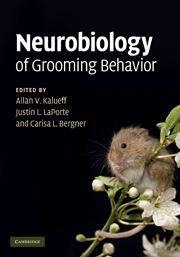Book contents
- Frontmatter
- Contents
- List of contributors
- Preface
- 1 Grooming, sequencing, and beyond: how it all began
- 2 Self-grooming as a form of olfactory communication in meadow voles and prairie voles (Microtus spp.)
- 3 Phenotyping and genetics of rodent grooming and barbering: utility for experimental neuroscience research
- 4 Social play, social grooming, and the regulation of social relationships
- 5 Grooming syntax as a sensitive measure of the effects of subchronic PCP treatment in rats
- 6 Modulatory effects of estrogens on grooming and related behaviors
- 7 Lack of barbering behavior in the phospholipase Cβ1 mutant mouse: a model animal for schizophrenia
- 8 Grooming after cerebellar, basal ganglia, and neocortical lesions
- 9 Striatal implementation of action sequences and more: grooming chains, inhibitory gating, and the relative reward effect
- 10 An ethological analysis of barbering behavior
- 11 Should there be a category: “grooming disorders?”
- 12 Neurobiology of trichotillomania
- Index
- References
5 - Grooming syntax as a sensitive measure of the effects of subchronic PCP treatment in rats
Published online by Cambridge University Press: 04 August 2010
- Frontmatter
- Contents
- List of contributors
- Preface
- 1 Grooming, sequencing, and beyond: how it all began
- 2 Self-grooming as a form of olfactory communication in meadow voles and prairie voles (Microtus spp.)
- 3 Phenotyping and genetics of rodent grooming and barbering: utility for experimental neuroscience research
- 4 Social play, social grooming, and the regulation of social relationships
- 5 Grooming syntax as a sensitive measure of the effects of subchronic PCP treatment in rats
- 6 Modulatory effects of estrogens on grooming and related behaviors
- 7 Lack of barbering behavior in the phospholipase Cβ1 mutant mouse: a model animal for schizophrenia
- 8 Grooming after cerebellar, basal ganglia, and neocortical lesions
- 9 Striatal implementation of action sequences and more: grooming chains, inhibitory gating, and the relative reward effect
- 10 An ethological analysis of barbering behavior
- 11 Should there be a category: “grooming disorders?”
- 12 Neurobiology of trichotillomania
- Index
- References
Summary
Summary
Grooming is increasingly recognized as a reliable marker of stress-related disturbances in animal models of neuropsychiatric disorders. We previously reported that subchronic exposure to 10 mg/kg of phencyclidine (PCP) for 15 days in rats increased grooming expression under both stressful and appetitive conditions, but impaired grooming syntax only when the behavior was elicited with stressful water sprays directed at the face. For the purpose of this chapter, new indexes from the same rats subjected to the water spray condition were analyzed. Results showed that the PCP group aborted less chains after face washing and spent a lower proportion of time in anterior grooming than control animals. Phencyclidine treatment also increased incorrect chain initiations and enhanced the duration of Phase IV within completed syntactic chains. Finally, PCP-injected rats were less engaged in nongrooming activities, and were more inactive. In a context where grooming was needed rostrally after facial contacts with water sprays, these results indicate that subchronic PCP treatment compromised hygiene efficiency and engendered an unfocused and perseverative grooming, most likely combined with an abnormal stress response. These observations suggest that the two leading approaches in the study of grooming patterning may provide pivotal sets of qualitative observations that help identify hygienic and stress-related irregularities in animal models.
- Type
- Chapter
- Information
- Neurobiology of Grooming Behavior , pp. 88 - 107Publisher: Cambridge University PressPrint publication year: 2010



